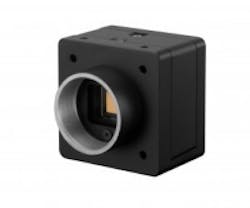Sony at VISION 2016: CMOS vs. CCD, Sony camera development philosophy
During my own personal whirlwind at VISION 2016, I had the chance to speak with Matt Swinney, Senior Marketing Manager, Image Sensing Solutions, at Sony Imaging Sensing Solutions. During our conversation, we spoke about the now well-known IMX CMOS sensors, new cameras from the company, new applications the company is involved in, and the transition from CCD to CMOS.
First, I learned a bit about the new Sony XCL-SG510 cameras (pictured), which feature a Camera Link interface and the Sony IMX250 image sensor. This sensor is a 5.1 MPixel global shutter CMOS sensor that can reach speeds of 154 fps.
"We saw that end users needed more resolution," said Swinney. "5 MPixel could be the new 'standard resolution,' and this is why we launched this product."
This product targets a number of applications, he said, citing machine vision, intelligent transportation systems, and more. He also discussed the benefits of some of the features of the cameras, which include a wide dynamic range, area gain, and multi region-of-interest mode. These camera and others are developed as a result of interactions with customers, and in particular, those in high-end applications, he noted.
"We have a lot of experience on the consumer side. When we look to solve customer problems, we can look at our expertise in all areas to help solve an issue. We ask what needs to be solved, and we show them what we can do."
When I inevitably turned the conversation a bit toward image sensors, Swinney talked a bit about how the company’s experience developing cameras helps when it comes to maximizing the sensors.
"IMX sensors are the best image sensors because we are a camera manufacturer, and we know how to make cameras that maximize these sensors," he said. "We have so much experience across so many different markets, and if you understand the customer, you can address the necessary points in the development of the sensor."
Perhaps Swinney was hoping I wouldn’t ask, but I was curious about the opinion of the rise of CMOS image sensors, and the decline in use of CCD, so I thought I would at least ask. As it turns out, he was willing to comment.
"CCD image sensors have a real use and are still sold. We just released our last CCD product a year ago. The issue is that CMOS global shutter sensors are a natural transition point."
He added, "You can extend and innovate with CMOS."
Some of the latest applications that Swinney indicated Sony is or has been involved with include drones and autonomous vehicles, and 3D imaging.
"Depends on the application, but we are generally able to work with our customers on their project, as we are always looking at new technologies to get into."
View more information on Sony Imaging Sensing Solutions.
Share your vision-related news by contacting James Carroll, Senior Web Editor, Vision Systems Design
To receive news like this in your inbox, click here.
Join our LinkedIn group | Like us on Facebook | Follow us on Twitter
Learn more: search the Vision Systems Design Buyer's Guide for companies, new products, press releases, and videos
About the Author

James Carroll
Former VSD Editor James Carroll joined the team 2013. Carroll covered machine vision and imaging from numerous angles, including application stories, industry news, market updates, and new products. In addition to writing and editing articles, Carroll managed the Innovators Awards program and webcasts.
